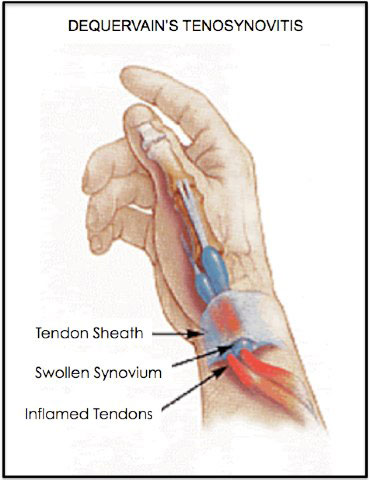WHAT IS TENDONITIS? (Also called Tendinitis, Tenosynovitis or Tendinopathy)
Tendons are the tough cords of tissue that attach muscles to bones. They help your muscles move your bones. Tendonitis is the inflammation and irritation of these tendons. If the normal smooth gliding motion of a tendon is impaired the tendon will become inflamed and tendonitis will start to occur. It causes pain and tenderness near a joint. Tendonitis, if it’s caught early, can be easily treated and cured.
It usually occurs in the shoulders, elbows, knees, hips, heels or wrists. Depending on its location, it may have a specific name, such as Tennis Elbow, De Quervain’s, or Trigger Finger for example.
Injuries and overuse are common causes of tendinitis. Cross training (varying your sporting activity regularly), stretching before exercise, and decreasing your intensity when you exercise might help prevent tendinitis. Certain diseases, such as rheumatoid arthritis, also can cause it.
You can usually treat tendinitis with rest, ice and medicine to relieve pain and decrease swelling. Other treatments include ultrasound, physical therapy, steroid injections and surgery.
Some commonly encountered types of tendonitis around the hand, wrist and elbow are described below:
TENNIS ELBOW (LATERAL EPICONDYLITIS)
Tennis Elbow is a degenerative or traumatic condition that occurs in the tendons that attach to the outside of the elbow. As the name indicates, Tennis Elbow is common to racket sports players, although it can also appear in individuals who participate in any activity that demands repetitive use of the forearm muscles (hand gripping and wrist turning activities) like playing cricket, raking, painting, lifting heavy bags and briefcases, and even dentistry.
Interestingly, golfers also commonly get this condition, where it occurs on the outside of the non-dominant elbow. Symptoms include pain on the outside of the elbow that travels into the forearm and general difficulty gripping and twisting. The pain can sometimes travel into the upper arm or forearm.
Tennis Elbow is usually first treated with rest, icing, anti-inflammatory medications, physical therapy, counter-force bracing and the injection of Cortisone. There is increasing evidence that Platelet rich plasma (PRP) treatments may also be effective. Severe and recalcitrant cases may require arthroscopic or minimally invasive surgery.
Read more about Tennis Elbow on our website.
Read more about Golf related injuries of the upper limb.
GOLFER’S ELBOW (MEDIAL EPICONDYLITIS)
Golfer’s Elbow on the other hand, causes pain on the inner aspect of the elbow. It is an overuse injury manifested by inflammation of the tendons at the origin of the flexor-pronator forearm muscles at the medial epicondyle (of the humerus bone) located on the inner elbow. Common in the dominant elbow of golfers, pitchers and carpenters, the condition results in pain and tenderness at the site of inflammation and weakness of the hand and wrist.
Golfer’s Elbow normally responds to rest, icing, anti-inflammatory medication and physical therapy. Platelet rich plasma (PRP) may be an option. Surgery may be needed in resistant cases, to remove the damaged portion of tendon and reattach it to the bone.
DE QUERVAIN’S TENDONITIS
De Quervain’s Tendonitis is a condition that occurs due to constriction and irritation of swollen tendons around the base of the thumb resulting in pain, tenderness, swelling and an inability to twist the wrist or grasp objects. Painful thumb extension is characteristic.
It is common in peri-menopausal or pregnant women, though men can also suffer from it. It is also common to musicians, waiters, housewives, racquet sports or fishing enthusiasts who use repetitive and forceful side-to-side wrist motions, De Quervain’s Tendinitis can present in patients from adolescence to old age.
The condition may respond to rest, icing, splinting, anti-inflammatory medications or cortisone injection. In severe, recurrent or chronic cases, surgery may be recommended to relieve constriction.
Read more about De Quervain’s Tendonitis on our website.
INTERSECTION SYNDROME
Intersection Syndrome is a condition in which the radial-side (thumb-side) wrist extensor tendons that cross under the wrist retinaculum (a fibrous band of fascia that covers the carpal bones) become irritated from overuse. The long thumb extensor tendon is sometimes involved too.
Activities that entail repeatedly moving the wrist up and down – such as tennis, rowing, kayaking or skiing, can lead to Intersection Syndrome, which causes pain on the back of the forearm a few inches below the wrist as well as a creaking sensation as the tendons rub against the extensor retinaculum.
The condition is normally treated by rest, splinting, anti-inflammatory medications and cortisone injection, followed by physical therapy. Surgery is only occasionally required.
ECU (EXTENSOR CARPI ULNARIS) TENDONITIS
ECU Tendinitis is a condition common among people who play racquet sports or basketball and involves an inflammation of the tendon that runs along the back of the wrist on the side of the little finger.
Any repetitive action from a non-ergonomically correct position that entails twisting or backward flexing of the wrist—like returning a tennis ball or shooting a basket—can put strain on the ECU tendon to the point of tenderness, pain and actual tearing.
Heavy and repetitive use of the ergonomically poor or unsupported wrist, while using a mouse or computer keyboard may also contribute to this condition.
Mild cases of ECU Tendinitis can be treated with rest, splinting and non-steroidal anti-inflammatory medications, whereas severe instances can necessitate cortisone injection or surgery to repair the tendon and its sheath.
TENDONITIS OF THE FINGERS (TRIGGER FINGER)
Trigger Finger, Trigger thumb or Trigger digits, is a common condition in which manifests with pain and impaired motion of the fingers, often with catching, snapping or locking of the involved finger. Symptoms may include tenderness on the palm near the base of the affected finger. The condition is most often caused by overuse and repetitive gripping activities or trauma, but some patients may have a genetic predisposition, or other diseases like rheumatoid arthritis and other autoimmune disorders.
Mild cases of Trigger Finger generally respond well to rest, splinting, gentle exercises, anti-inflammatory medication, ergonomic training and cortisone injection. More persistent cases may benefit from surgical release.
Read more about Trigger Finger on our website.
Can Tendinitis or tenosynovitis cause numbness of the fingers?
Certain activities and sports that require prolonged and/or repetitive wrist flexion/extension movements and heavy gripping can result in inflammation of the tendons that travel through the carpal tunnel on the palmar aspect of the wrist. This increases the pressure within the carpal tunnel and compresses the median nerve, which also travels through this confined space. This condition is called Carpal Tunnel Syndrome, and causes numbness of the thumb, index and middle fingertips, in addition to palmar wrist pain. Office clerical workers, factory line workers and sportsmen may suffer this condition.
Read more about Carpal Tunnel Syndrome and treatments for this, on our website.
For more information on simple home based treatments that may help your tendinitis, read our next blog post.
What can I do for my tendinitis now?
When you get tendinitis, try these 5 simple steps first – Protection, Rest, Ice, Compression and Elevation. [Acronym P.R.I.C.E] It can help speed your recovery and help prevent further problems.
Protection. Immobilise the affected area to encourage healing and to protect it from further injury. You may need to use elastic wraps, slings, splints, crutches or canes.
Rest. Avoid activities that increase the pain or swelling. Don’t try to work or play through the pain. Rest is essential to tissue healing. But it doesn’t mean complete bed rest. You can do other activities and exercises that don’t stress the injured tendon. Swimming and water exercise may be well tolerated.
Ice. To decrease pain, muscle spasm and swelling, apply ice to the injured area for up to 20 minutes, every 3 to 4 hours for 2 or 3 days. Ice packs, ice massage or slush baths with ice and water all can help. For an ice massage, freeze a plastic foam cup full of water so that you can hold the cup while applying the ice directly to the skin.
Compression. Because swelling can result in loss of motion in an injured joint, compress the area using wraps, sport tape or compressive elastic bandages (crepe bandages) until the swelling has ceased.
Elevation. Raise the affected part above the level of your heart to reduce swelling. For example, elevate your wrist on the back of a chair or couch while sitting or on a pillow while sleeping.
Although rest is a key part of treating tendinitis, prolonged inactivity can cause stiffness in your joints. After a few days of completely resting the injured area, gently move it through its full range of motion to maintain joint flexibility.
You can also try non-steroidal anti-inflammatory drugs (NSAIDs), such as mefenamic-acid and ibuprofen, or products containing acetaminophen (Paracetamol, Panadol etc.) which help to reduce the inflammation and discomfort associated with tendonitis.
For more information on how you can prevent and minimise your risk of getting tendinitis, read our next blog post
What can I do to prevent tendonitis and associated injuries?
To reduce the likelihood of developing tendonitis, follow these suggestions:
Avoid aggravating activities that place excessive stress on your tendons, especially for prolonged periods. If you notice pain during a particular exercise, stop and rest.
Cross Train. If one exercise or activity causes you a particular, persistent pain, try something else. Cross training helps you alternate an impact-loading exercise, such as running, with lower impact exercise, such as biking or swimming. And it keeps your exercise regimen interesting!
Focus on and improve your technique. When your technique in an activity or exercise is flawed, you could be putting your tendons at risk of injury. Consider taking lessons or getting professional instruction when starting a new sport or using new exercise equipment.
Warm up before you exercise. Before engaging in your sporting activity, take time to stretch in order to maximise the range of motion of your joints. This can help to minimise repetitive micro-trauma on tight tissues. Also remember to stretch after exercise.
Use proper workplace ergonomics. At your workplace, get a proper ergonomic assessment. Fitting your workspace to your body is essential to ensure that no tendons are continually stressed or overloaded. Examples include using a gel wrist support, making sure the computer screen is at the right height and use lumbar support if necessary to improve your working posture.
Prepare your muscles to play. Strengthening muscles used in your activity or sport can help them better withstand stress and load.
Dr. Jonathan Y. Lee, a leading Singapore Hand Surgery and Orthopedic upper limb Specialist, discusses tendonitis, a common cause of pain around the hand, wrist and elbow.




















